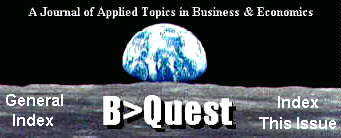|
|
|
October 27, 2004 |
|
|
|
October 27, 2004 |
When the Nobel laureates in economics for this year
were announced, I immediately thought this would be another year when I did
not know who the recipients were and what they did.
Until two years ago, I was aware of some work by each economics Nobel
laureate that had been picked since the prize began in 1969.
However, while I knew about the experimental economics
studies that began about 15 years ago and are important at Georgia State
University, which has a very well developed experimental lab, I did not know
the important contributors to that process who were honored two years ago.
I originally thought that this year’s award to Edward
Prescott and Finn Kydland would be another recognition of new economic ideas
whose founders went beyond my expertise.
Then I realized that I had used an article co-authored by them on the
“real business cycle” in my class on economic dynamics.
I had thought the article was interesting but wrong
Beginning at the economics convention held in Atlanta
in 1979, economists began to question the separation of economics into
aggregates, such as consumption and investment, on the one hand, and
individual choice and the response to price behavior in individual markets
on the other. Instead of saying
there is something that explains consumption, economists began to say if we
added up all the individual decisions of households trying to make
reasonable economic choices, how much would they consume?
Some of my readers who had economics in college before
the mid 1980s would be shocked to learn that this method of thinking brought
the theories of John Maynard Keynes and Milton Friedman together as two
examples of markets out of equilibrium.
They were both special cases of market conditions that were
inconsistent with households and corporate leaders making reasonable
economic choices.
A few years ago, George Akerloff and Joe Stiglitz
received Nobel recognition for uncovering why those disequilibrium special
cases in theory were relatively frequent in fact.
Therefore, traditional policy methods of dealing with imbalances had
merit according to their works.
Furthermore, the Prescott and Kydland group, who became
known as neo-classical, were having trouble showing how reasonable
individual decisions could spawn economic cycles.
If everyone was making appropriate decisions based upon available
economic information, how did we get “mistakes” that led to economic
downturns.
In the paper I used for my class, Prescott and Kydland
argued that unexpected supply shocks, such as a shift in the market
structure of oil (e.g. the 1973 boycott or the 1979 Iranian revolution)
caused the past information to be inappropriate, leading to wrong decisions.
This information failure was then transmitted through a process based
upon behavioral and institutional barriers that prevented immediate
adjustment to the new reality.
Instead of using some temporary measure to bolster
purchasing power and spending during this adjustment process (we call them
recessions), policy should work upon avoiding the supply shocks to the
extent possible ( but how do you stop a revolution) or changing the
behavioral barriers.
Actually, this thinking led to readjustments of
monetary policy in South America and Eastern Europe that have substantially
eliminated the previous bouts of hyper-inflation and their economic
distortions. Because
Prescott’s work, in particular, provided the backbone for national central
banks to alter their inflation bent policy, he certainly has contributed to
economic well-being. Not many
economists can have that said about their work.
Unfortunately, China also is following similar monetary principles. To insure predictability in the purchasing power of their currency, they effectively have borrowed the history of another, the dollar. This worked for Bulgaria and may have aided the price stability of Argentina (although Argentina suffered a serious recession in initiating the dollar based peso). In China, competitiveness has become so altered by the falling dollar that serious world distortions in industrial structure may be developing.
So what is wrong with Prescott and Kydland’s papers
on “real business cycles.” As
George Akerloff showed in his auto lemon paper, price denotes more than
scarcity.
Harvard business school has an “urban myth”
(something assumed to be true but no one knows why) about students who
discovered a synthesized perfume that was so well done that no consumer
testing could differentiate between it and the $30 per ounce real stuff.
It cost about $1 to make. They
put it on the market at $5, a very profitable mark-up, and it failed.
Another group of students bought the rights to the
production process, sold the perfume at $25 and they made millions. The
moral: price not only reflected
economic costs, but also product quality.
At $25, customers assumed it was the good stuff at a bargain.
At $5 they knew it was synthetic, which meant cheap and not worth a
try.
By failing to understand the dual role of price,
consumers will periodically make purchasing errors that will lead to
economic distortions requiring recessionary adjustments.
That is not permitted in the Prescott and Kydland process.
Nevertheless, the “real business cycle” is a major economic effort in macro-economics that deserves the recognition it received with the latest Nobel awards. That only economists can understand the true importance of this effort should not diminish its significance.
